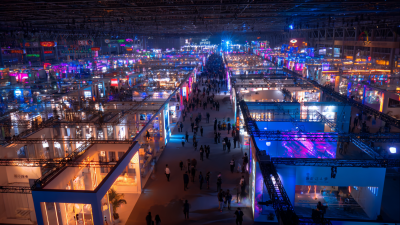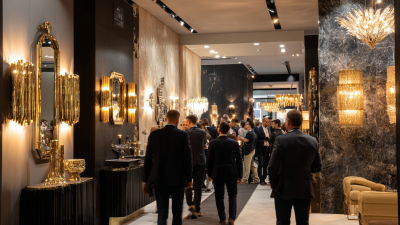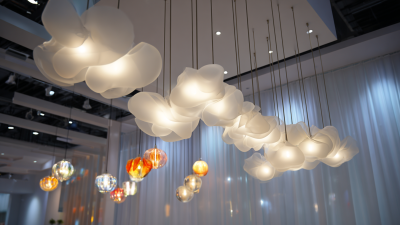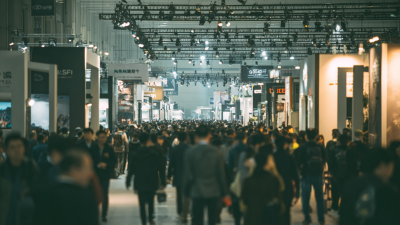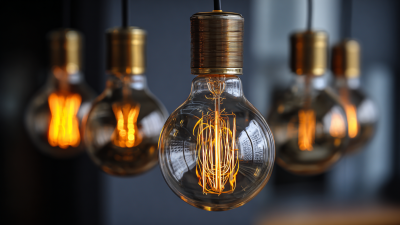 Lighting plays a crucial role in shaping our environments and influencing our daily lives, with an increasing number of studies highlighting the psychological effects of different types of lamps lighting. According to a report from the American Psychological Association, proper lighting can enhance productivity, reduce stress, and even improve sleep quality. For instance, warm white light is associated with relaxation, making it ideal for living spaces, while cooler tones can boost alertness and focus, making them better suited for work or study areas.
Lighting plays a crucial role in shaping our environments and influencing our daily lives, with an increasing number of studies highlighting the psychological effects of different types of lamps lighting. According to a report from the American Psychological Association, proper lighting can enhance productivity, reduce stress, and even improve sleep quality. For instance, warm white light is associated with relaxation, making it ideal for living spaces, while cooler tones can boost alertness and focus, making them better suited for work or study areas.
Furthermore, the proliferation of smart lighting technology has made it easier than ever to customize our lighting environments to suit specific moods and activities. Understanding the science behind lamp types—from LED to incandescent—enables consumers to make informed choices that not only enhance aesthetic appeal but also foster emotional well-being. By illuminating our spaces thoughtfully, we can significantly impact our mood and daily performance.
When it comes to enhancing our living and working environments, the type of lamp we choose plays a crucial role in determining the atmosphere of a space. There are several types of lamps available that cater to different lighting needs, including incandescent, fluorescent, LED, and halogen lamps, each with unique characteristics. According to the U.S. Department of Energy, LED lamps use at least 75% less energy and last 25 times longer than incandescent lighting, making them not only a sustainable choice but also a significant contributor to reducing household energy costs.

Incandescent lamps, known for their warm light, have a high color rendering index (CRI) of around 100, which means they accurately represent colors, positively influencing mood and ambiance. However, they produce a lot of heat and are less energy-efficient. On the other hand, fluorescent lights tend to flicker, which can lead to eye strain over prolonged exposure. The World Health Organization notes that poor lighting conditions can affect mental health, emphasizing the importance of choosing the right type of lamp to foster a conducive atmosphere. As consumers become increasingly aware of the implications of lighting on both physical and mental well-being, the shift towards LED lamps is not just a trend but a necessity for creating spaces that promote comfort and productivity.
The color temperature of light significantly impacts the atmosphere of a space and can directly influence our mood. Generally measured in Kelvin (K), warm light (typically around 2700K to 3000K) exudes a cozy, inviting ambiance. This type of lighting is perfect for areas designed for relaxation and social interaction, such as living rooms or bedrooms. Research shows that warm light can enhance feelings of comfort and lower stress levels, making it an ideal choice for creating an intimate setting.
In contrast, cool light (ranging from 4000K to 6500K) promotes alertness and focus, making it suitable for workspaces or kitchens. The more bluish tones of cool light mimic daylight, which can boost productivity and energy levels. However, excessive exposure to cool light, especially in the evening, may disrupt our circadian rhythm and affect sleep quality. Understanding the effects of warm versus cool light enables individuals to tailor their environment to suit specific activities and moods, enhancing both comfort and efficiency in everyday life.
This chart illustrates how different color temperatures of light affect mood, using a scale from 1 to 10 to indicate mood enhancement. Warm light (below 3000K) tends to create a cozy atmosphere, while cool light (above 5000K) enhances alertness and focus.
The importance of lumens in indoor lighting cannot be overstated, as they significantly influence not only the aesthetic quality of a space but also psychological well-being. Research indicates that adequate brightness levels, measured in lumens, directly correlate with enhanced cognitive function and mood stabilization. For instance, investigators have highlighted how dynamically adjusting indoor lighting brightness and color throughout the day can improve sleep quality and physical activity, particularly among older adults. This versatile approach to lighting design can lead to positive emotional responses, fostering a more productive and pleasant living environment.
Moreover, light pollution remains an issue in urban settings, as over-illumination can disrupt natural behaviors and impact mental health. While blue light is often celebrated for its stimulating qualities during daytime hours, it poses challenges for evening relaxation, as excessive exposure can hinder sleep onset and contribute to mood disorders. Effective lighting strategies thus require a balance of illuminance and color temperature, which can elicit desirable emotional responses. A study on emotional reactions to varying light conditions suggests that a careful selection of lighting settings can mitigate feelings of seasonal affective disorder, particularly during the shorter, darker days of winter, thereby enhancing overall mood and well-being.
| Lamp Type | Lumens | Brightness Level | Typical Use | Psychological Impact |
|---|---|---|---|---|
| Incandescent | 800 | Moderate | General Lighting | Warm and Cozy |
| LED | 1000 | Bright | Task Lighting | Energizing |
| Fluorescent | 1600 | Very Bright | Commercial Spaces | Focus and Alertness |
| Halogen | 1000 | Bright | Accent Lighting | Invigorating |
| Smart Lamp | 800-1200 | Adjustable | Dynamic Spaces | Customizable Mood |
When designing a space, understanding the different types of lighting is crucial for crafting an environment that fosters productivity and relaxation. Task lighting, which includes desk lamps or reading lights, is essential for activities that require focus. This type of lighting typically provides direct illumination, reducing eye strain and enhancing concentration. By strategically placing task lights in workspaces, individuals can create an efficient environment that promotes a greater sense of control and motivation.
Ambient lighting serves as the overall illumination in a room, setting the mood and atmosphere. This type of lighting can be achieved through overhead fixtures or soft lamps that diffuse light evenly throughout the space. A warm ambient glow can evoke feelings of comfort and tranquility, making it ideal for living areas and bedrooms. Balancing ambient lighting with task lights ensures that a space is not only functional but inviting, allowing individuals to switch from focused activities to relaxation seamlessly.
Accent lighting adds dimension and visual interest, highlighting specific areas or objects within a room. This can be achieved through spotlights, wall sconces, or even decorative lamps that cast intriguing shadows. By incorporating accent lighting, homeowners can draw attention to artwork or architectural features, enhancing the overall aesthetic appeal of the space. Together, task, ambient, and accent lighting create a harmonious balance that caters to various needs, positively influencing mood and productivity.

The design of a lamp goes beyond its functional role, playing a crucial part in shaping our emotional environment. Aesthetically pleasing lamp designs can evoke feelings of comfort, creativity, or energy, depending on their form and materials. For instance, soft curves and warm colors in a lamp can create a soothing atmosphere, making a space feel more inviting and relaxed. In contrast, sleek, modern designs with bright light can instigate focus and productivity, ideal for workspaces.
Moreover, the emotional responses elicited by lamp designs can significantly influence social interactions and personal well-being. A well-placed, stylish lamp in a living room can act as a conversation starter, enhancing connections between guests. In personal sanctuaries, choosing lamps that reflect one’s style can foster a sense of identity and ownership, contributing to mental health. Thus, the interplay between lamp design and emotional response underscores the importance of thoughtful aesthetics in lighting; it shapes not just how we see our spaces, but also how we feel within them.
